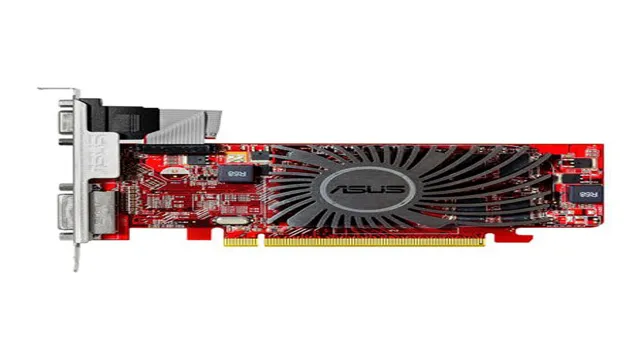Are you perplexed about what a DDR3 Graphics Card is and its significance? Look no further! A DDR3 Graphics Card is a type of graphics card that uses DDR3 memory. GPUs or Graphics Processing Units are built into graphics cards to display high-resolution images, perform parallel calculations, and execute instructions to improve the overall visual experience of a computer. DDR3 is an older type of memory that was widely used in graphics cards until DDR4’s advancement, but it still has the potential to run most programs smoothly.
Imagine DDR3 as a reliable old car that can still take you from point A to point B despite being outdated. In this blog, we’ll go into further detail about DDR3 Graphics Cards to address any lingering questions you might have.
Understanding DDR3 Technology
DDR3 technology is a type of RAM memory used in many modern computers and graphics cards. So, what is a DDR3 graphics card exactly? To put it simply, it’s a graphics card that uses DDR3 memory for its video memory. This type of memory was first introduced in the mid-2000s and has since become a popular choice for computer memory due to its relatively high speeds and low power consumption.
Compared to its predecessor DDR2, DDR3 offers faster data transfer rates and increased bandwidth, allowing for smoother and more efficient performance. DDR3 technology has been widely adopted by the industry, and many graphics cards now use it to power the intensive demands of modern gaming and video editing. So, if you’re looking for a graphics card that can handle the latest games and demanding applications, a DDR3 graphics card is a great choice.
DDR3 vs DDR4
DDR3 technology is a popular type of computer memory that has been in use for several years. It is known as double data rate third-generation synchronous dynamic random access memory, and its performance is determined by its clock speed and bandwidth. DDR3 operates at a maximum clock speed of 2133 MHz and has a maximum bandwidth of 17 GB/s.
This technology is widely used in various computer systems, including laptops, desktops, servers, and workstations. One of the most significant benefits of DDR3 is its affordability, making it a popular choice among consumers. Additionally, DDR3 technology provides satisfactory performance for most computing applications, including basic office tasks, web browsing, and light gaming.
Overall, DDR3 technology has been a reliable and cost-effective choice for many years, and it continues to be a prevalent memory type in many computer systems.

Benefits of DDR3 Graphics Card
DDr3 graphics card is a type of graphics card that uses DDR3 memory to provide superior graphical performance. DDR3 is a type of RAM that is faster and more efficient than its predecessor, DDR DDR3 graphics cards are designed to deliver high-quality visuals and smooth gameplay experiences, making them ideal for gaming and other graphics-intensive applications.
One of the benefits of DDR3 graphics cards is their ability to handle high resolutions and complex graphics with ease, resulting in a more immersive gaming experience. Additionally, DDR3 graphics cards are more energy-efficient than their predecessors, consuming less power while delivering better performance. These features make DDR3 graphics cards a popular choice for gamers, graphic designers, and other professionals who demand top-notch graphics performance from their computers.
Improved Performance
If you’re a gamer or a graphic designer, you probably want a high-performance graphics card that can keep up with your demands. DDR3 graphics cards offer a number of benefits that make them a great choice. First, they have improved performance compared to the older DDR2 cards.
DDR3 cards offer faster clock speeds and improved memory bandwidth, which means they can process more data at once. This leads to smoother performance and faster load times, especially when running multiple applications at once. Another benefit of DDR3 graphics cards is that they consume less power than older cards, which translates to lower energy bills and reduced heat output.
Additionally, they offer better support for high-resolution displays and can handle more demanding games and applications with ease. In short, if you’re looking for a high-performance graphics card, DDR3 is a great choice.
Cost Effective
DDR3 graphics card DDR3 graphics cards are a great investment for anyone looking to upgrade their gaming experience without breaking the bank. Compared to their DDR2 counterparts, DDR3 graphics cards offer a significant increase in bandwidth, allowing faster performance and smoother gameplay. They also consume less power and generate less heat, making them more cost-effective in the long run.
DDR3 graphics cards are also more future-proof, as they are compatible with newer CPUs and motherboards. The added benefits of a DDR3 graphics card make it the perfect choice for gaming, video editing, and other graphics-intensive tasks. So, if you want to enhance your computer’s performance and take your gaming experience to the next level, consider investing in a DDR3 graphics card.
Compatibility
When it comes to choosing a graphics card, compatibility with your hardware is crucial. One of the biggest benefits of a DDR3 graphics card is its compatibility with a wide range of systems. This type of graphics card is designed to work seamlessly with older motherboards and systems that don’t have the latest technology.
This means that you can upgrade your graphics card without having to replace your entire system, making it a cost-effective choice. Additionally, a DDR3 graphics card can improve the performance of older systems, giving you better gaming experiences and faster video rendering times. Overall, if you’re looking for a reliable and compatible graphics card, a DDR3 option is an excellent choice.
DDR3 Graphics Card Specifications
If you’re in the market for a new graphics card and have come across the term “DDR3,” you may be wondering what it means. DDR3 refers to the type of memory used on the graphics card. This memory is faster than its predecessor, DDR2, and has higher bandwidth, allowing for better performance when it comes to gaming, video editing, and other graphics-intensive tasks.
When looking at the specifications of a graphics card, you’ll want to pay attention to the amount of DDR3 memory it has, as well as its clock speed. These factors can make a significant difference in the overall performance of the card. However, it’s important to note that DDR3 is an older technology, and many newer graphics cards now use DDR4 or even GDDR6 memory.
So if you’re looking for the latest and greatest in graphics card technology, you may want to consider a newer model that uses these updated memory types. Nevertheless, DDR3 graphics cards are still widely available and can provide you with solid performance for most tasks.
Memory Size
When it comes to DDR3 graphics card specifications, one of the most important factors to consider is the memory size. The memory size, often referred to as VRAM, determines the amount of data that a graphics card can store and process in real-time. This is particularly important when it comes to gaming, as high-quality textures and resolutions require more data to be processed at a faster rate.
While lower-end graphics cards may have 1 or 2 GB of VRAM, higher-end models can have upwards of 8 or 16 GB. But, just because a graphics card has a high VRAM doesn’t necessarily mean it’s the best option. Other factors, such as clock speed and processing power, also play a role in determining a graphics card’s overall performance.
So, it’s important to consider all of these factors when choosing a DDR3 graphics card for your gaming needs.
Memory Speed
When it comes to buying a graphics card, one of the most important specifications to pay attention to is the DDR3 memory speed. DDR3 memory refers to the type of memory used by the graphics card, and the speed at which this memory operates can have a significant impact on the card’s overall performance. Higher DDR3 memory speeds generally lead to better performance, but it’s important to note that the DDR3 memory speed isn’t the only factor that determines the performance of a graphics card.
Other factors such as the graphics processing unit (GPU) and the amount of memory on the card also play a significant role. So, when shopping for a graphics card, be sure to take all of these factors into consideration to find the best card for your needs.
Memory Bandwidth
When it comes to graphics cards, DDR3 memory bandwidth is an important specification to consider. Memory bandwidth refers to the amount of data that can be transferred between the GPU and the memory in a given amount of time. DDR3 memory is a type of RAM that is commonly used in graphics cards, and the amount of DDR3 memory bandwidth a card has can impact its performance.
Higher bandwidth means the card can handle more data at once, which can result in smoother gameplay and better graphics. When comparing different graphics cards, you should look for one with a higher DDR3 memory bandwidth if you want the best performance possible. Keep in mind that other factors, such as the GPU itself, also play a role in overall performance.
Conclusion
In conclusion, a DDR3 graphics card is like the brain powering the visuals of your computer. Just like how we need our brains to process information and make decisions, a DDR3 graphics card is essential for rendering beautiful images and animations on your screen. It’s the unsung hero of the gaming world, quietly working behind the scenes to bring your virtual world to life.
So the next time you’re playing your favorite game, take a moment to appreciate the hardworking DDR3 graphics card that’s making it all possible – it’s the ultimate wingman for your gaming adventures.”
FAQs
What is DDR3 in a graphics card?
DDR3 is a type of memory used in graphics cards to store and access data quickly. It is a slower and older technology compared to DDR4 and GDDR5.
Is DDR3 graphics card still relevant in 2021?
DDR3 graphics cards can still be used for basic tasks like internet browsing and document processing. However, for gaming and other demanding applications, a DDR4 or GDDR5 graphics card is recommended.
Can I upgrade my DDR3 graphics card to a DDR4 or GDDR5?
No, DDR3 graphics cards are not compatible with DDR4 or GDDR5 memory. Upgrading to a new graphics card is recommended.
What is the difference between DDR3 and GDDR5 in graphics cards?
GDDR5 is a much faster memory technology compared to DDR3. It can handle more data transfer and provides better performance for gaming and other demanding applications.


